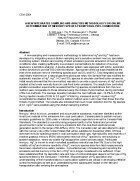Air Monitoring
A NEW INTEGRATED SAMPLING AND ANALYSIS METHODOLOGY FOR ONLINE DETERMINATION OF MERCURY SPECIES FROM FOSSIL FUEL COMBUSTION
Oct 06 2014
Author: S. Win Lee, I. He, R. Dureau and V. Razbin on behalf of CEM
Abstract
A new sampling and measurement methodology to determine Hg0 and Hg2+ has been developed by integrating source dilution sampling and a sensitive ambient mercury speciation monitoring system. Dilution and cooling of stack emissions promote simulation of near ambient conditions while creating sufficiently low emission concentrations for detection of mercury species by a sensitive analyzer. A double-dilution system was equipped with online, automatic control functions to provide 500-2400 fold dilution. Appropriate chemical traps installed at the inlet of the analyzer remove interfering species such as SO2 and HCl. This integrated concept was initially examined on a natural-gas-fired pilot-scale rotary kiln furnace that was modified for systematic injection of Hg0, Hg2+, HCl and SO2 species to simulate coal-fired boiler emissions. Initial results showed that the new method was able to provide a good recovery of Hg0 and Hg2+ injected at the levels normally found in coal-fired boiler emissions. The results from controlled parallel combustion experiments revealed that the Hg species concentrations form the new method were comparable to those obtained using the Ontario Hydro Method, during controlled of the two methods. The average deviation between the two methods was −14.6% to 8.6% at the Hg injection levels of 0.06 to 3.0 μg/m3 of total Hg, measured as Hg0. However Hg2+ concentrations obtained from the source dilution method were much lower than those from the Ontario Hydro Method. The results also indicated that much lower detection limit for Hg species at 0.1 ng/m3 were possible using the dilution sampling method.
Introduction
Mercury, which is a toxic, persistent and accumulative substance, has been identified as the most toxic material in the emissions from coal combustion. Canada plans to publish mercury emission guidelines by 2005 under a national regulatory agenda known as the Canada Wide Standards. The standard is currently being prepared jointly by the federal and provincial governments in order to reduce mercury emissions form the coal-fired electrical power generation sector in the range of 60-90% by 2010. The Canadian plan will also attempt to align with the mercury rule of the United States that will be published in December 2004. Of three dominant mercury species present in coal combustion stack gas, high solubility and reactivity of reactive gaseous mercury (RGM) allow partial removal of Hg2+ species by wet scrubbing or sorbent adsorption, where as volatile Hg0 escapes the control devices easily. Particulate mercury, Hgp, is known to exist in smallest quantities normally less than 5%. Due to the high volatility of Hg0 and extreme reactivity of Hg2+, mercury species data from field measurements have been reported to be widely variable. Conventional way of measuring and reporting the emissions as total mercury in the form of Hg0 is no longer considered to be sufficient. It has been established that Hg deposition rate and type of control strategies depend on the type of Hg species emitted by the combustor. Therefore, characterization of Hg speciation and understanding of their transformations in combustion systems are critical in developing effective control technologies as well as in understanding their subsequent impact on the fate and transportation after entering the atmosphere.
The mercury monitors currently available for source testing utilize pre-cleaning or preconcentrating chemical solutions to remove interfering components of the stack gas before detection of the two gaseous Hg species (1,2). These continuous monitors usually measure and report Hg concentrations in stack emissions that are detected at one particular sampling time or snap shot information and are non-representative of changing field boiler operating conditions. In addition, they are sampled under high stack temperature regimes and are not comparable to the actual emissions detected in the atmosphere. Since little is known about transformation and fate of the mercury after leaving the stack, measuring the species under simulated atmospheric conditions, such as in source dilution sampling could provide simulated plume species concentrations that would account for the atmospheric transformation effects (3-5). Recently, source dilution sampling methods have gained increased attention due to their ability to provide realistic ambient-compatible data for source apportionment modeling. A new integrated concept of flue gas dilution and removal of acid gases as pre-treatment, to be followed by on-line Hg species detection using an ambient analyzer for source emissions sampling was evaluated. This approach would also allow for integrated sampling of emissions over longer periods to capture more realistic plant releases, compared with a very short, grab-sampling approach. This proof-of-concept was examined on a natural-gas-fired combustion system, which was modified to allow for simulation of coal-fired boiler emissions. It was recognized that the tests would not fully address the effects of other parameters that may be encountered during coal-fired combustion. However, we believe that the new concept could be most effectively tested by using a simpler and cleaner combustion system with Hg injection before moving to a more complicated and costly coal-fired combustion system. The paper describes the results from the initial phase of this research.
Digital Edition
AET 28.2 April/May 2024
May 2024
Business News - Teledyne Marine expands with the acquisition of Valeport - Signal partners with gas analysis experts in Korea Air Monitoring - Continuous Fine Particulate Emission Monitor...
View all digital editions
Events
Jul 10 2024 Birmingham, UK
Jul 21 2024 Cape Town, South Africa
Australasian Waste & Recycling Expo
Jul 24 2024 Sydney, Australia
Jul 30 2024 Jakarta, Indonesia
China Energy Summit & Exhibition
Jul 31 2024 Beijing, China















